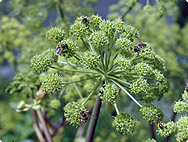A.Vogel search
When the internal search is activated, personal data such as your IP address is transmitted to our search engine Cludo. Data is thus transferred to a third country. Please click here if you want to display the internal search. You can find more information on data protection here: Privacy policy.
A.Vogel plant encyclopaedia
Angelica archangelica L.
Angelica
History

The term angélica is Middle Latin and was derived from the Greek aggelikós and ággelos meaning ’messenger’ or ’angel’. Legend has it that an angel showed mankind the healing plant. Archangélica comes from the Greek word archággalos meaning ‘archangelic’, which is the superlative of angelica, and strongly emphasises the particular medicinal value of the plant.
The first reference to Angelica was in the 14th century by Matthaeus Sylvaticus. In 1588, Tabernaemontanus wrote of “Angelica with its extraordinary power and virtue, as if the Holy Ghost or the dear angels had revealed this plant and wholesome root to mankind.” According to him, the plant was primarily used in hospitals for infectious diseases to counteract ‘plaguey and pestilential air’. He also called it ‘poison root’ as it could be used in cases where poison was either eaten or drunk.
Botanical characteristics

Angelica has a powerful tap-root and a dense root system. This produces a lush leaf rosette, from which, in the second year, a hollow, grooved stalk grows up to a height of 2 metres. The uppermost part of the stalk is branched. The large leaves are much cut into and become smaller, the higher up the stalk they are. They are attached to the stalk with a broad leaf sheath and are tripinnate.
Greenish-white flowers stand in semicircular, apical double umbels that can reach up to 15cm in diameter. The fruits are oval and schizocarpic, i.e. split into several indehiscent one-seeded portions. The plant comes into blossom once and then dies.
Angelica flowers from July to August.
Habitat

Angelica thrives in moist locations in the temperate climes of Europe and Asia, and as far north as Iceland. The wild plant is prevalent in the coastal regions of the North and Baltic Seas, but is seldom found in Austria or Switzerland.
Preparation
Angelica seeds are sown in the springtime. In October and November, the roots and root stocks of plants grown in organic cultivation are dug up, washed, and dried. These are used to produce an alcohol extract.
Angelica is an ingredient in liqueurs such as Chartreuse and Bénédictine and bitter schnapps.